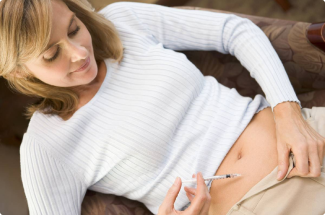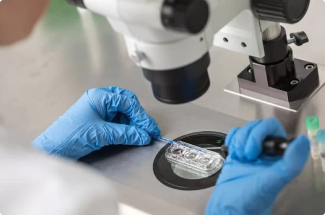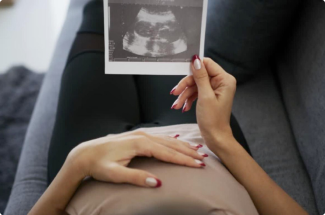The process of in vitro fertilization

IVF is a procedure of artificial fertilization of an egg outside a woman’s body, followed by the transfer of embryos into the uterus and the development of pregnancy. The IVF process consists of several stages: preparation and activities directly related to fertilization.
Preparation for the IVF procedure
To increase the chances of successful IVF, it is important to prepare for it properly. Future parents need to undergo a comprehensive diagnostic examination.
The diagnostics have two main goals: to evaluate reproductive function and to identify health disorders that can negatively affect fertility and pregnancy. The scope of examinations for each couple will vary depending on age, medical history, and past illnesses.
The basic list of diagnostic examinations for women includes:
- Clinical and biochemical blood analysis and coagulogram.
- Blood analysis for sexually transmitted infections (HIV, hepatitis B and C, chlamydia).
- Determination of hormone levels: anti-Müllerian hormone (AMH), prolactin, follicle-stimulating hormone (FSH), luteinizing hormone (LH), progesterone, estradiol.
- Gynecological examination.
- Pelvic ultrasound (ultrasound examination of the pelvic organs).
- Consultation with a therapist and gynecologist.
The list of examinations for men is usually shorter. The potential father needs to determine his blood type and Rh factor, undergo testing for sexually transmitted infections, and provide a semen analysis (spermogram).
If acute infectious or inflammatory diseases are detected during the diagnostic stage, they need to be treated. Chronic illnesses should be brought into a state of remission. It is essential for a woman to enter the pregnancy period in the best possible state of health.
How long does the IVF process take?
To begin with, it’s important to understand how IVF works. The procedure itself involves extracting eggs from the woman’s body, obtaining sperm from the prospective father, and fertilizing the cells in a laboratory setting. Within about 24 hours of the cell fusion, it can be determined whether fertilization has occurred.
If an embryo is formed as a result of cell fusion, it is placed in special conditions with the same levels of oxygen and carbon dioxide as the uterine cavity. In this environment, the embryo develops for up to 5 days before being transferred to the uterus.
Therefore, the actual in vitro fertilization procedure takes 5-7 days. However, a significant amount of time is required for preparation leading up to IVF. The diagnostic stage takes 2-3 months. The period of ovulation stimulation, which occurs prior to IVF, ranges from 28 to 45 days. Consequently, a single IVF cycle can take up to 4.5 months.
The IVF Process Step by Step
After the diagnostics and treatment of acute and chronic diseases, the main IVF process begins. It consists of several stages. Let’s understand how the IVF procedure works step by step.

Ovulation Stimulation
The success of IVF largely depends on the quantity and quality of eggs (oocytes) retrieved for fertilization. Usually, around 10-15 eggs are used.
A healthy woman with a normal menstrual cycle cannot have such a number of oocytes simultaneously. Normally, only one egg matures during a cycle. To obtain more oocytes, ovulation stimulation is performed before IVF. Hormonal medications are prescribed to stimulate the growth of multiple oocytes within the follicles. These medications are usually administered through injections.
There are different types of stimulation protocols, which vary in terms of timing and the specific hormonal medications used. Most reproductive specialists use standard stimulation protocols, such as the short or long protocol.
The short protocol begins on the 3rd to 5th day of the menstrual cycle and lasts for 10-12 days.
The long protocol starts on the 18th to 21st day of the cycle and lasts for 3-4 weeks. It involves suppressing the production of luteinizing hormone (which stimulates follicle growth) with medications and then stimulating ovulation.

Follicular Aspiration (Egg Retrieval)
When the ovulation stimulation course is completed, matured eggs are retrieved for fertilization. The retrieval is done through follicular aspiration, a minimally invasive procedure performed under local anesthesia or in a medicated sleep state. It involves puncturing the follicles through the vaginal vault under ultrasound or CT guidance to ensure precise movements by the doctor.
After the procedure, the woman is monitored by medical professionals in the clinic for 2-4 hours. All retrieved oocytes are carefully examined for viability, and only the highest-quality cells are selected for fertilization.

Sperm Retrieval
Sperm retrieval usually involves masturbation after 3-5 days of abstinence. For most men, this period of abstinence results in the best quality of sperm
If ejaculation is not possible for any reason or if there is a complete absence of sperm in the ejaculate (e.g., in cases of azoospermia), testicular biopsy may be performed to retrieve the sperm cells. The procedure is done under local anesthesia or in a sedated state.
Only healthy sperm, exhibiting proper progressive motility, are selected for IVF.

Fertilization
There are two methods of fertilization:
Traditional Method: The retrieved eggs are placed in a Petri dish containing a nutrient medium. At this stage, the cells are kept in conditions that closely resemble the environment of the fallopian tubes, including temperature, oxygen concentration, and carbon dioxide levels.
Approximately 4-10 hours after follicular aspiration, a suspension of sperm, specifically selected for IVF, is added to the oocytes. The fusion of the two gametes occurs naturally, without external intervention.
After 24 hours of adding the sperm suspension, it becomes clear whether fertilization has occurred and which cells have been fertilized. This marks the embryological stage of IVF.
ICSI (Intracytoplasmic Sperm Injection). The reproductive specialist examines the quality of the sperm and selects the healthiest and most motile one. Using a fine needle, the selected sperm is injected directly into the egg. If multiple eggs are available, several sperm may be chosen.

Cultivation of the Obtained Embryos
The obtained embryos are placed in an artificial medium where the composition and temperature are strictly controlled. The embryologist’s task is not only to culture the embryos and maintain their viability but also to carefully monitor the developmental process. Over a period of 3-6 days, the specialist evaluates the embryos using a specific scale. Based on various parameters, the doctor determines the quality of the embryos as high, medium, or below average. On the 5th day, the embryo reaches the blastocyst stage, which is the optimal time for transfer to the uterus.

Embryo Transfer
Prior to the procedure, 1-2 of the highest-quality and viable embryos are selected. In some cases, 3 embryos may be transferred to the uterus, which increases the chances of successful implantation and pregnancy. However, transferring more than 3 embryos is not recommended as it raises the likelihood of multiple pregnancies and associated risks during gestation and childbirth.
A special catheter is used for the embryo transfer, which is very thin and does not require artificial dilation of the cervical canal. The introduction of the catheter is painless.
Implantation, the attachment of the blastocyst to the uterine lining, occurs within 2-8 days after the embryo transfer. In IVF, late implantation is usually observed because the embryo needs time to adapt to the new environment.
What medications are used in IVF?
Medications are prescribed during the ovulation stimulation phase and after the embryo transfer into the uterine cavity. For ovulation stimulation, a combination of three hormones is typically used:
- Gonadotropin-releasing hormone (GnRH) antagonists: These medications suppress the secretion of follicle-stimulating hormone (FSH) and luteinizing hormone (LH) and allow for ovulation control. By using GnRH antagonists, ovulation does not occur too early, and all the oocytes remain within the follicles until the follicular aspiration is performed.
- Gonadotropins: These medications stimulate the growth and development of follicles. They are responsible for the maturation of a large number of oocytes.
- Medications based on human chorionic gonadotropin (hCG): These drugs act similarly to the body’s own luteinizing hormone. Under their influence, the oocyte matures and prepares for fertilization.
The specific combination and sequence of these medications depend on the chosen ovulation stimulation protocol.
Normally, after the release of the oocyte from the follicle, a temporary secretory gland called the corpus luteum forms in its place. The corpus luteum produces estrogen and progesterone, hormones necessary for pregnancy and sustaining the fetus. The formation of the corpus luteum is triggered by luteinizing hormone.
After ovulation stimulation and follicular aspiration, the corpus luteum may not form. In such cases, a medication-based support of the luteal phase is conducted. This involves the administration of progesterone, estradiol, and human chorionic gonadotropin. Typically, luteal phase support continues for 14 days from the day of embryo transfer into the uterine cavity.
Even if all the stages of the IVF process are carried out correctly, there is no guarantee of a successful pregnancy. The average success rate of IVF procedures is approximately 40%. If pregnancy does not occur after IVF, it does not mean that you cannot become a parent. Surrogacy offers an opportunity to have a child, and this auxiliary reproductive technology is widely and successfully used worldwide.